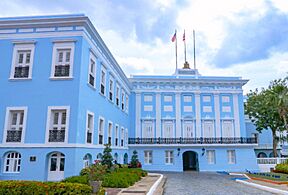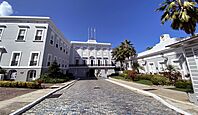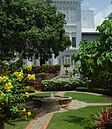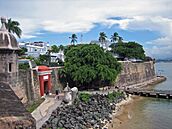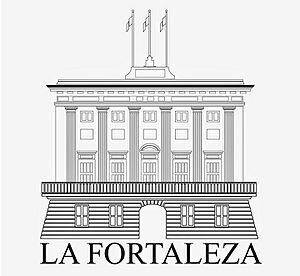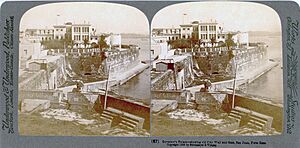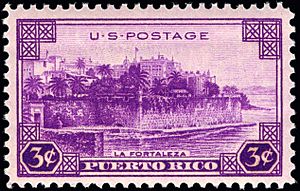La Fortaleza facts for kids
Quick facts for kids La Fortaleza |
|
|---|---|
|
Palacio de Santa Catalina
|
|
|
From top, left to right: Wide view of front façade (east) of La Fortaleza; close-up view of front façade (east); close-up view of Calle de la Fortaleza (Fortaleza Street); close-up view of Jardín Hundio ("sunken garden") next to side façade (north); wide view of side façade (north) above Puerta de San Juan (San Juan Gate); wide view of rear façade (west) from San Juan Bay; and aerial view of La Fortaleza within the Walls of Old San Juan and above Paseo de la Princesa in Old San Juan
|
|
| General information | |
| Type | Medieval fortification, Castle, Palace, Mansion |
| Architectural style | Fortification, Spanish Renaissance, Neoclassical |
| Location | Old San Juan, San Juan, Puerto Rico |
| Address | 63 Calle Fortaleza, San Juan, Puerto Rico 00901 |
| Coordinates | 18°27′51″N 66°7′9″W / 18.46417°N 66.11917°W |
| Construction started | 1533 |
| Completed | 1540 |
| Known for | Battle of San Juan (1595) Battle of San Juan (1598) Battle of San Juan (1625) Battle of San Juan (1797) Bombardment of San Juan (1898) |
| Type: | Cultural |
| Criteria: | vi |
| Designated: | 1983 (7th session) |
| Part of: | La Fortaleza and San Juan National Historic Site in Puerto Rico |
| Reference #: | 266 |
| Region: | The Americas |
| Official name: La Fortaleza | |
| Designated: | October 9, 1960 |
| Official name: La Fortaleza | |
| Designated: | October 15, 1966 |
| Reference #: | 66000951 |
La Fortaleza (which means "the fortress" in English), also known as the Palacio de Santa Catalina (Saint Catherine's Palace), is the official home and office of the governor of Puerto Rico. It is located in the historic area of Old San Juan, the capital city.
This building has been the governor's home since the 1500s. This makes it the oldest executive mansion in the Americas that has been used continuously. It was first built as a medieval fortress between 1533 and 1540 by order of King Charles I of Spain. Later, it was updated to its current Neoclassical style in 1846.
La Fortaleza was the first fort built by the Spanish on San Juan Islet. Its purpose was to protect San Juan Bay, the main harbor of Old San Juan. Along with other forts like El Morro and San Cristóbal, it helped protect Puerto Rico. Puerto Rico was very important for its location, often called "The Key to the Indies." These forts kept the island safe from other powerful countries and from privateers and pirates during the Age of Discovery. In 1983, La Fortaleza was named a World Heritage Site.
La Fortaleza is on the western side of San Juan Islet in Old San Juan. It is where the governor's office is located. It is about 1.6 kilometers (1 mile) from the Capitol of Puerto Rico, where the laws are made. It is also about 3.2 kilometers (2 miles) from the Supreme Court Building, where legal decisions are made.
Contents
What La Fortaleza Looks Like
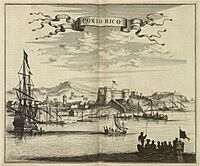
La Fortaleza was the first defensive building in Old San Juan. The city was originally called Ciudad de Puerto Rico (meaning "rich port city"). It was the first of many military buildings made to protect the city, including the San Felipe del Morro Fortress and the San Cristóbal Fortress. King Charles V of Spain ordered its construction to defend against attacks from the Island Caribs and other European countries.
At first, the building had four walls around a central courtyard. It also had a round tower called the Homage Tower. From the top of this tower, the governor would promise loyalty to the King and Queen of Spain during important times. Later, a second tower, called the Austral Tower, was added.
During a rebuilding in the 1640s, a chapel dedicated to Santa Catalina Alejandría was added to the fort's walls. This is why the building is also known as Palacio de Santa Catalina (Saint Catherine's Palace).
Today, La Fortaleza is made up of several connected buildings. The formal living areas are on the second floor, and private rooms are on the third. The building looks out over the tall city walls facing San Juan Bay. Inside the northern part of the property, there are peaceful gardens and a swimming pool. The outside of the palace has been painted white, light blue, and light gray over the years.
History of La Fortaleza
In 1529, Governor La Gama asked the emperor to build defenses. He said the island needed protection because people were leaving due to its defenseless state. Construction began in 1533 using stone and finished by 1540. However, the fort did not have any cannons at first. One person, Gonzalo Fernández de Oviedo y Valdés, even said it was built in a terrible spot. Still, the building has been the governor's home since 1544.
Since the 1500s, La Fortaleza has been the home of the Governor of Puerto Rico. This makes it the oldest executive mansion in the Americas that is still in use. In 1846, the Spanish authorities changed the mansion. They made it less like a military fort and more suitable for its new role as an administrative building.
La Fortaleza has been taken over by foreign powers three times:
- In 1598, George Clifford, the Earl of Cumberland, attacked San Juan.
- In 1625, General Boudewijn Hendricksz from the Netherlands invaded the city and took over La Fortaleza. When the Dutch left, they set the fortress and the city on fire.
- In 1898, the U.S. Navy invaded and took control of Puerto Rico. They set up a temporary government.
In 1834, Colonel George Dawson Flinter described the Santa Catalina fortress. He noted it had a chapel, stables, a water tank, and a large east wing with spacious rooms.
According to a story, in 1898, just before the United States invaded Puerto Rico during the Spanish–American War, the last Spanish governor, Ricardo de Ortega y Diez, hit a tall clock in La Fortaleza with his sword. He stopped the clock, marking the exact moment Spain lost control of Puerto Rico.
On October 30, 1950, some nationalists tried to enter La Fortaleza. This event is known as the San Juan Nationalist revolt. They wanted to attack the governor at the time, Luis Muñoz Marín. A five-minute shootout happened, and four nationalists died. Three of the building's guards were also seriously hurt.
On October 9, 1960, La Fortaleza was named a United States National Historic Landmark. Teodoro Vidal, a cultural official, helped organize renovation work on the building around this time.
In 1983, La Fortaleza and the San Juan National Historic Site were declared a World Heritage Site by UNESCO. This means they are considered very important to the world's history and culture.
Interesting Facts About La Fortaleza
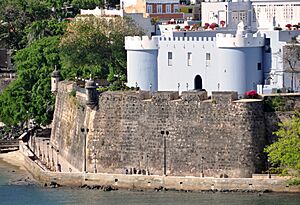
- La Fortaleza has two towers: the Astral Tower and the Homage Tower. These towers show that it was originally built as a military structure.
- The Homage Tower contains the Santa Catalina Chapel. Inside, there is a beautiful mosaic made of 95,000 pieces, honoring the Holy Trinity.
- In 1956, workers uncovered an area in the Austral Tower that might have been the old kitchen of La Fortaleza.
- The paintings displayed at La Fortaleza are borrowed from the Institute of Puerto Rican Historical Culture. They are changed based on what the current governor likes.
- Originally, La Fortaleza was painted salmon red. This was a common color for military buildings in Puerto Rico during the Spanish colonial period. Its wooden doors were green, and its columns were white with gold details.
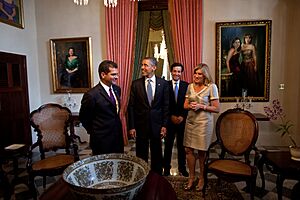
- Several U.S. Presidents have visited La Fortaleza. These include Herbert Hoover in 1931, Harry S. Truman in 1948, John F. Kennedy in 1961, Barack Obama in 2011, and Bill Clinton in 2013.
- La Fortaleza has been home to 156 governors. This includes 124 under Spanish rule, 19 under U.S. rule, and 13 Puerto Ricans.
- Three flags fly over La Fortaleza: the Puerto Rican flag, the American flag, and the Governor's white flag. If the white flag is not flying, it means the governor is not at the palace.
- The Hundido Garden was renamed Doña Inés Garden. This was in honor of Doña Inés Mendoza, who was the wife of former governor Luis Muñoz Marín. It was her favorite spot at La Fortaleza, where she lived for 16 years.
Gallery
-
Reception of the U.S. President Herbert Hoover to La Fortaleza in 1931
-
Calle de la Fortaleza leading to the palace with a canopy of the Monoestrellada (Monostarred) flag of Puerto Rico
Interesting Facts About La Fortaleza
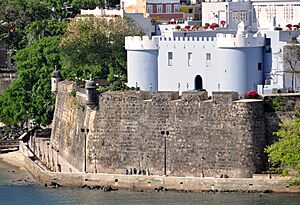
- La Fortaleza has two towers: the Austral Tower and the Homage Tower. These towers show that it was first built as a military structure.
- The Homage Tower contains the Santa Catalina Chapel. Inside, there is a colorful mosaic made of 95,000 pieces. It honors the Holy Trinity.
- In 1956, workers found what might have been the old kitchen of La Fortaleza. It was discovered in the Austral Tower when a covered area was opened.
- The paintings displayed at La Fortaleza are borrowed from the Institute of Puerto Rican Historical Culture. They are changed based on what the current governor likes.
- Originally, La Fortaleza was painted salmon red. This was a common color for military buildings in Puerto Rico during the Spanish colonial period. Its wooden doors were green, and its columns were white with gold details.

- Several U.S. Presidents have visited La Fortaleza. These include Herbert Hoover (1931), Harry S. Truman (1948), John F. Kennedy (1961), Barack Obama (2011), and Bill Clinton (2013).
- La Fortaleza has been home to 156 governors. This includes 124 under Spanish rule, 19 under U.S. rule, and 13 Puerto Ricans.
- Three flags fly over La Fortaleza: the Puerto Rican flag, the American flag, and the Governor's white flag. If the white flag is not flying, it means the governor is not at the palace.
- The Hundido Garden was renamed Doña Inés Garden. This was done to honor Doña Inés Mendoza, who was the wife of former governor Luis Muñoz Marín. It was her favorite place at La Fortaleza, where she lived for 16 years.
See also
 In Spanish: La Fortaleza (Puerto Rico) para niños
In Spanish: La Fortaleza (Puerto Rico) para niños


